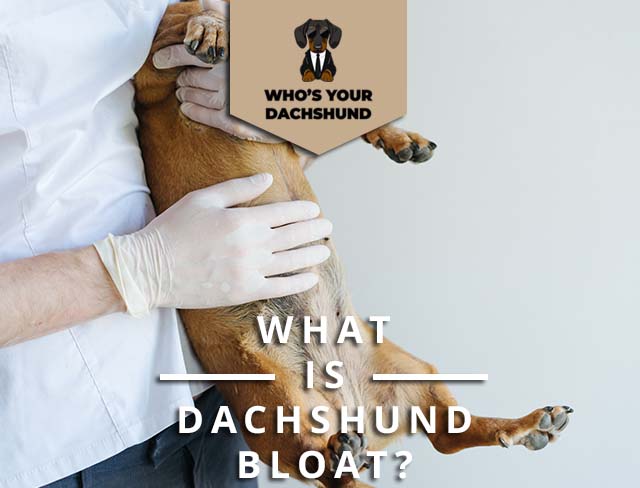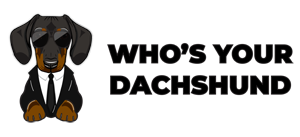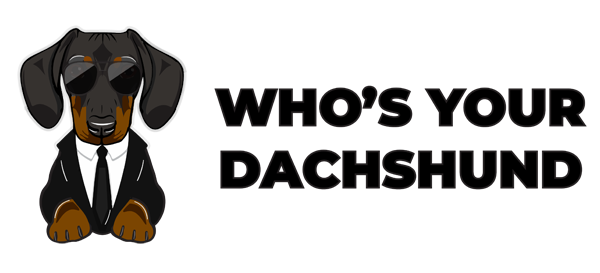
Dachshund Bloat is the layman’s term for Gastric Dilatation and Volvulus Syndrome, or GDV. A dog’s stomach becomes twisted by gas, leading to a severe and life-threatening condition.
What Causes Dachshund Bloat?
Dachshunds are genetically predisposed to bloating, although it’s not their fault. They have short, deep bodies and long guts, making them prone to twisting in the gut. Many different factors can contribute to bloat: eating too fast, obesity, exercise right after eating, consuming a lot of water with meals or shortly after that, dry food that is rich in fat (some brands hold extra air in the tiny kibble pieces), genetics (certain lines of Dachshunds seem to be more prone than others), hormonal changes (pregnancy and nursing), spaying/neutering and stress.
How Serious is Dachshund Bloat?
Bloating can be a life-threatening condition, and it is the number one killer of Dachshunds. But that’s not because bloating itself is fatal; it’s because there are so many things that can go wrong simultaneously, such as dehydration, intestinal blockages, ruptures from twisting intestines all the way around in the gut, etc. If immediate action isn’t taken and your dog manages to struggle for help for even several hours (or longer), severe and permanent damage can occur.
How Common is Dachshund Bloat?
Bloat is very common in Dachshunds. The average lifespan is 12-15 years, but Bloating causes 10-15% of all Dachshunds each year, making it the most deadly condition to affect Dachshunds.
Treatment for Dachshund Bloat
The most important thing that you can do to keep your Dachshund safe is to get him to a veterinary clinic as quickly as possible, where the staff will help assess his condition and figure out what’s happening. If your veterinarian finds that bloat has started, he/ she may recommend a treatment called gastric lavage. The stomach is washed out with a particular solution (water or saline) to remove gas and debris from the digestive system. The main problem is that some dogs don’t like it. If they try to vomit during the procedure, they become even more distressed and often are not helped by being kept on long enough to work through their systems.
Prevention of Dachshund Bloat
The best way to prevent it is with a gastropexy surgical procedure, which involves suturing the stomach to the body wall. It also can be done through laparoscopy for females that are not spayed. It does not prevent all bloat cases, but it significantly reduces the risk. It will also reduce the risk of your Dachshund developing another medical problem known as Gastric Dilatation-Volvulus Syndrome.
Besides, you should feed your Dachshund smaller meals throughout the day and not exercise for at least an hour after eating (that includes playing ball in an enclosed space).
What causes the condition?
Bloating is extremely common in Dachshunds. They are prone to this condition because they have a short, deep body and a longer digestive tract. One of the most significant causes of bloating is an over-consumption of food or a meal with multiple servings. The meal can have too much fat in it or too many small kibble pieces, and they expand into a gas quickly, causing bloating or an upset stomach.
The second most common cause of bloating in Dachshunds is stress. Some dogs will become stressed when they are taken from their familiar surroundings to be seen by medical staff when something isn’t right with them. In this case, the stress can cause a Bloat episode.
Other causes that do not directly cause bloating in their dogs include gastric torsion and gastric volvulus.
Some dogs with Gastric Dilatation Volvulus Syndrome do not have Dachshund Bloat; it is a condition known as Bloat without Dachshund Bloat Syndrome BVD for short. The individual dog may be suffering from something other than bloating but at the same time suffer from gastric dilatation or volvulus (when the stomach twists and rotates inside the body).
How is it diagnosed?
There are many Bloat signs, all of which should be taken seriously. If your Dachshund exhibits any of the following traits, get it to a veterinarian as soon as possible: excessive lethargy, inability to stand up or walk on his own (he can still move if an assistive device is used), vomiting, or loss of consciousness.
Dachshund Bloat can be diagnosed by taking a complete medical history and performing a physical exam. Your veterinarian may suggest taking your dog to an ECC for a series of x-rays and an ultrasound.
After an X-ray is taken, doctors may recommend introducing a Gastrografin test. That is done by diluting a test solution with water, then placing it into the dog’s stomach through the rectum. The solution coats stomach walls and then comes out of the body through the intestines after a few hours. If bubbles in the fluid from the gas passing through them, this helps confirm bloat.
Depending on your dog’s medical condition and its severity, treatment will vary. For instance, if your dog is vomiting or unable to stand because of distress, it will be treated first with drugs (antihistamines or medications that suppress nausea).
Gastric Dilatation-Volvulus
Gastric Dilatation-Volvulus, commonly abbreviated to GDV, is a life-threatening condition in many large breed dogs. Essentially, the stomach becomes dilated and then rotates or volvulus, spilling its contents into the abdominal cavity. The dog can die from its blood supply blockage because it cannot digest food.
The condition may be hereditary (though not all dogs that have it are related). It can also be caused by an inherited defect such as:
- Gastroschisis
- Intestinal malrotation
- Poor stomach development
Genetic predisposition is suspected in up to 45% of cases. Common medical conditions associated with GDV include vacuoles in the liver (often accompanied by ascites) and hypoadrenocorticism; such cases are rare but more severe forms that result from pituitary tumors, epilepsy, rabies, and other diseases.
The owner should notify the veterinarian they are taking the dog to get the dog’s emergency medical kit immediately. If your pet is experiencing vomiting and diarrhea, the vet will recommend IV (intravenous) fluids to ward off dehydration. For this surgery, your vet will want to keep your dog overnight at the hospital.
Once GDV occurs, there is no cure; only treatment of symptoms. If a large portion of stomach tissue has become detached from the main organ, it may be possible to re-attach it using a stapler or staples. However, such treatments are usually unsuccessful if the intestines have become twisted too tightly into themselves.
Signs typically indicate that GDV is underway. Most signs are not severe at first but will intensify as the process moves along. That can result in a dog whose stomach is distended, becoming more prominent as it becomes larger and begins to empty. The stomach will be darker in color to a pale shade of greenish-yellow, with blood-tinged mucus or debris flowing from the intestines into the abdominal cavity.
If an obstruction is present, vomiting and abdominal pain may occur early on; further signs include pale gums and skin, rapid heart rate, panting, weak pulse (this may mean your pet’s internal organs are failing).
What can be done to treat Bloating or GVD?
Owners or bystanders should first ensure the dog’s safety by confining the pet to an area such as a bathroom and immediately contacting a veterinarian. A rupture risk is too significant for the dog to be moved if severely bloated. If you cannot reach your veterinarian immediately (or if it is an emergency that you cannot wait for), then have someone drive you directly to a 24-hour animal hospital or emergency veterinary clinic. Do not wait for your veterinarian’s office to open in the morning! The longer your pet goes untreated, the higher the likelihood of death or severe complications from bloat for GVD.
Can the condition be prevented?
Can the condition be prevented? It is in no way inevitable that those who suffer from chronic pain will wish to live with it indefinitely. Consequently, there are several ways to take preventative measures to avoid this.
More and more veterinarians recommend dogs get spayed or neutered, which decreases the incidence of unwanted litters and the ongoing costs associated with having to care for them. It’s also preventing their owners from having to cope with GDV in the first place. Dogs should be neutered around six months of age, and again at the time, they come into heat.
Dogs bred primarily for hunting are also prone to GDV simply because they tend to live a long time and have a lot of physical activity built into their lifestyle. The more activity they have between hunting sessions; however, the more risk they face developing this condition themselves.
5 Warning Signs of Bloat That Could Save Your Dog’s Life
- Drooling
If your dog is drooling more than usual, it could be a warning sign that he’s close to suffering from bloat. When you try to check out his stomach area’s condition, and it’s complex and extended, this is also a warning sign. If you see this condition on your dog, then it’s recommended that you rush him to the veterinary hospital as soon as possible.
- Retching
One of the best warning signs of bloat for dogs is retching without throwing up any contents from their stomachs. Most dogs will retch without throwing up when they’re about to throw up or having an episode of bloat itself. If your dog is retching, it’s time to call the vet as soon as possible.
- Getting up and down quickly, trying to grab their stomach
Many dogs that suffer from bloat will try to get up or squat on their feet, signifying that they are obviously in pain. If your dog struggles to do this, then it’s recommended that you call the vet as soon as possible. (It’s always recommended that you avoid touching your dog at all times if he’s having an episode of bloat)
- A yellow tinge on the gums
At this stage, dogs may appear to have a yellow tinge on their gums before going into full-blown bloat. The gums may also turn pale. If your dog has contracted bloat, at this stage, it will be in severe pain and will need urgent veterinary treatment as soon as possible.
- Vomiting blood
If your dog is vomiting blood, this is a warning sign that he’s in severe pain, and it’s time to call the vet. If your dog is vomiting blood, don’t try to self-medicate him with medicine or other means of remedying it. That could make him even more stressed and cause more stomach issues than before (and your vet will likely let you touch him only after the procedure is completed).
Bloat Prevention – Non-Surgical
- Feed your Dachshund smaller meals throughout the day, and not exercise for at least an hour after eating (that includes playing ball in an enclosed space).
- Avoid feeding your Dachshund any substances that are known to cause bloat, which includes corn, grapes, raisins, and macadamia nuts, among others.
- Keep any food out of reach when not serving it to your dog. A dog that overeats too fast is more susceptible to bloat than a dog that takes its time while eating.
- Exercise your Dachshund but not suitable after he’s eaten.
- Please do not allow your Dachshund to drink a lot of water while eating, and never allow him to exercise or play shortly after drinking any water.
- Please do not allow your Dachshund access to any table scraps, and especially nothing with onions in it.
- If your Dachshund has a bloating history, feed him in a different area than a food bowl for other dogs, including yours.
- If you have a Dachshund that has suffered from bloat in the past, make sure that you take him to a breed-specific veterinarian for an annual physical examination.
- If your dog is given medications or any supplements to help his diet be balanced and regulated, make sure that he is only receiving the recommended dose based on his size and weight to not have any problems later on.
- Have your vet examine your pet each year and take X-rays every two years to see if any changes in his bones indicate he may be at risk for bone disease.
Bloat Prevention – Surgical
- Please do not feed your Dachshund raisins, grapes, or sugary foods as they can cause elevated insulin levels, which lead to bloat.
- Exercise your Dachshund immediately after eating, and make sure it cools off after exercising before being fed again.
- Feed your Dachshund small meals throughout the day, and not exercise for at least an hour after eating (that includes playing ball in an enclosed space).
- Never allow your dog to drink too much water during meals, and avoid exercising or playing after he drinks water.
- If your dog is given medications or any supplements to help his diet be balanced and regulated, make sure that he is only receiving the recommended dose based on his size and weight to not have any problems later on.
Can a Dog Still Get Bloat After a Gastropexy?
Despite the gastropexy, a dog is still prone to bloat. Gastric dilatation-volvulus (GDV), also known as bloat, is caused by the stomach twisting itself or becoming too large for the body to handle. The condition can occur in several different types of dogs, but it primarily affects flat-faced breeds like the Dachshund and Miniature Schnauzer.
What Causes Bloat?
The precise cause of bloat is still unknown, but it is thought to occur due to diet or the digesting process triggering a neurological response that causes the stomach to swell suddenly. Bloating occurs because the stomach is more prominent than usual, so it presses against other organs in the abdomen such as the spleen and liver, which can lead to injury and organ failure.
Signs of Bloat in Dogs
The most common sign of bloat is a dog acting very out of character. Your dog may vomit or retch, or it may be lying down with its head between its front paws, but just as quickly as these behaviors start, they will abruptly stop. Bloat can quickly progress to cause severe damage to your dog’s stomach, organs, and other internal structures if treatment isn’t administered promptly. If your dog has the signs and symptoms of bloat listed above, you must take him to the vet as soon as possible for diagnosis and treatment so that he can recover.
Why Do Dogs Bloat?
Dogs often bloat or become swollen due to an imbalance in their stomachs. Many factors can cause a dog to bloat, such as overeating, eating too fast, lack of exercise, or anxiety. A bloated stomach can also be life-threatening if not treated quickly.
How Is Bloat Diagnosed?
There are several ways that your vet will diagnose bloat in your pet. Sometimes bloat can be seen and diagnosed by an X-ray or ultrasound (ultrasound exams). Other times it may have to be confirmed through a gastroscopy or necropsy (both involve using a tiny camera to take pictures of the stomach). You may want to ask your vet if he could recommend any articles, books, or other resources that go into more detail about how bloat is diagnosed before your appointment.
Treatment for Bloat in Dogs
The primary treatment method for bloat involves surgery. Your vet will perform an emergency gastrotomy, an incision made in the abdomen to give him access to your dog’s stomach for manual relief from the twisting. It involves making sure that your dog’s digestive tract starts working again safely and adequately.

